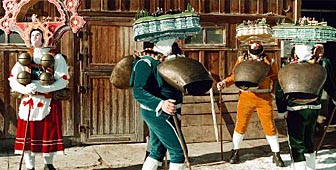Ushering in the “old” New Year

In a remote eastern corner of the country, the New Year has just been rung in. The ritual known as the "Silvester Klause" helps the people in some parts of Appenzell celebrate the New Year, according to the old Julian calendar.
On a cold winter’s morning, the bells make a frightening racket. Cows start mooing in protest, dogs bark in fear. The clanging can be heard high up on the steep hillsides outside the village of Urnäsch.
It’s not yet daybreak on January 13, and a group of men in costumes, with large cow and sleigh bells strapped to their bodies, are performing a wild dance, as if possessed, to draw people out of their farmhouse.
The eight men, all brothers, slowly form a circle and stand still. Their bells fall silent and they begin to yodel. It’s a melancholic melody and acts as an invitation for the family to move closer.
In time with the music, the curious family members step slowly around the outside of the circle, admiring the oversized and richly decorated headdresses worn by the “beautiful” Klause.
The bonnets portray Appenzell life in miniature. Wooden figurines and three-dimensional farmhouses have been carefully arranged, like theatre sets, on the flat wide-brimmed bonnets.
Small lights embedded in the hats illuminate the idyllic scenes: hand-painted farmers tend to their cattle and goats. Another chops wood. A boy peers out of house window, watching a horse-drawn sleigh ride past.
The brothers finish yodeling and begin their wild dance again. They’re appeased by an offering of mulled wine, slurped through a straw inserted through the mouths of the masks.
After three songs, they wish the family a happy new year and are given small bank notes in return. The brothers then dance noisily off across the frozen ground to the next farmhouse where they repeat the ritual.
“We’ve been ‘Klauses’ for about 30 years – not all together though because the younger ones were too small then,” says Walter, one of the older Frick brothers. “Our father used to do it. We simply enjoy it. Probably our great-grandfather did it as well.”
Not much is known about the origins of the Silvester Klause. It was first mentioned in Urnäsch in the middle of the 18th century and may have its roots in pagan rituals once performed to drive out evil spirits, similar to winter customs still practiced in many parts of Switzerland.
But in the poor Appenzell countryside, the ceremony developed into an elaborate form of begging and was banned by the church. In 1844, one local official called the Klause “beggars in disguise” and accused them of misusing cowbells for such a purpose.
The ritual was so strongly rooted in the community though, that the church eventually gave in, agreeing to tolerate the practice, but only on New Year’s Eve.
And the ritual would probably go largely unnoticed outside Appenzell today if it wasn’t for the refusal of the protestant population to recognize the calendar reform introduced by Pope Gregory XIII more than 300 years ago.
In Protestant parts of Appenzell, including Urnäsch, New Year’s Eve is still celebrated according to the old Julian calendar on January 13.
No longer beggars, it’s an honour to belong to one of the three kinds of Klause groups; either the “beautiful” like the brothers Frick, the “natural” or the “ugly”.
The “natural” Klause are covered from head to toe in pine branches and leaves, their faces hidden behind masks made from pinecone scales. Their bonnets are decorated with snail shells.
They are considered “less ugly” than the “ugly” Klause, who go as far as to fit animals’ teeth and horns onto their papier-mâché masks.
Studies have proven that there are striking similarities between the costumed ritual, particularly as it’s performed by the “ugly” Klause, and ceremonies performed by peoples in as far away places as Burkina Faso in West Africa.
“A lot goes into the costumes before they’re ready,” says an elderly man, Heinrich Müller. He takes a puff on his pipe as he watches the Frick brothers disappear in the mist. “Some of them work the whole year round on their costumes.”
He stays outside in the bitter cold to welcome the next group of Klause who, by the sound of their bells, aren’t far behind.
by Dale Bechtel

In compliance with the JTI standards
More: SWI swissinfo.ch certified by the Journalism Trust Initiative

You can find an overview of ongoing debates with our journalists here . Please join us!
If you want to start a conversation about a topic raised in this article or want to report factual errors, email us at english@swissinfo.ch.